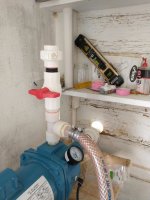Chucky_ott
Active Member
I'm trying to understand the failure mode so that I can prevent it again.
The picture shows the discharge port of my jet pump. In the picture, there is a nylon tee and nipple but when it failed, it was a PVC tee and nipple.
For some reason, the entire tee assembly popped out of the pump, spraying whatever water was left in the pressure tank inside the pump room. The pressure switch did not have a low pressure shut-off so the pump kept on working. Don't know for how long but it was still running when I noticed the problem, maybe an hour or so. Maybe more.
On closer inspection of the PVC nipple, it was obvious that it had deformed under heat. I need to understand how.
I'm thinking there are only two ways for enough heat to have been generated to melt the PVC:
1. pump has dead headed because of failed pressure switch
2. pump ran dry because of loss of prime and then dead-headed because cut-off pressure could not be reached
I'm fairly certain the pump did not dead head because of the pressure switch. The switch and all the contacts looked fine so I'm sure the pump shut off at the 60psi cut-off. And when i replaced the tee, it was working properly.
I'm 99% certain that water supply is not an issue. The pump is connected to a 10ft deep sand point close to a lake. Water table is about 1ft deep, pump is 3ft off the ground, so total lift of 4ft. It also has been supplying enough water after I made the necessary repairs.
So the only other possibility that I can think of would be a suction leak. When the pump was off (and the suction pipe was under pressure), there was a slight water leak at the 1-1/4" intake port. I'm assuming that a slight water leak when under positive pressure (pump off) would be enough to admit air when under negative pressure (pump on) and cause the pump to run dry (even if it had been working properly in the hours before). Are my assumptions correct ?
I have since replaced the pressure switch with one with a low-pressure shut-off and replaced the PVC tee with nylon. Luckily, the pump is still working and I have water again. But I doubt that the low pressure shut-off switch will do anything in the event of a suction leak IF NO WATER IS BEING USED. In this case, the system pressure could stay between the low-pressure shut-off and the cut-in of the pressure switch, effectively dead-heading the pump.
Am I correct, and if so, is there a sensor that can detect run-dry conditions for a 120 V jet pump?
The picture shows the discharge port of my jet pump. In the picture, there is a nylon tee and nipple but when it failed, it was a PVC tee and nipple.
For some reason, the entire tee assembly popped out of the pump, spraying whatever water was left in the pressure tank inside the pump room. The pressure switch did not have a low pressure shut-off so the pump kept on working. Don't know for how long but it was still running when I noticed the problem, maybe an hour or so. Maybe more.
On closer inspection of the PVC nipple, it was obvious that it had deformed under heat. I need to understand how.
I'm thinking there are only two ways for enough heat to have been generated to melt the PVC:
1. pump has dead headed because of failed pressure switch
2. pump ran dry because of loss of prime and then dead-headed because cut-off pressure could not be reached
I'm fairly certain the pump did not dead head because of the pressure switch. The switch and all the contacts looked fine so I'm sure the pump shut off at the 60psi cut-off. And when i replaced the tee, it was working properly.
I'm 99% certain that water supply is not an issue. The pump is connected to a 10ft deep sand point close to a lake. Water table is about 1ft deep, pump is 3ft off the ground, so total lift of 4ft. It also has been supplying enough water after I made the necessary repairs.
So the only other possibility that I can think of would be a suction leak. When the pump was off (and the suction pipe was under pressure), there was a slight water leak at the 1-1/4" intake port. I'm assuming that a slight water leak when under positive pressure (pump off) would be enough to admit air when under negative pressure (pump on) and cause the pump to run dry (even if it had been working properly in the hours before). Are my assumptions correct ?
I have since replaced the pressure switch with one with a low-pressure shut-off and replaced the PVC tee with nylon. Luckily, the pump is still working and I have water again. But I doubt that the low pressure shut-off switch will do anything in the event of a suction leak IF NO WATER IS BEING USED. In this case, the system pressure could stay between the low-pressure shut-off and the cut-in of the pressure switch, effectively dead-heading the pump.
Am I correct, and if so, is there a sensor that can detect run-dry conditions for a 120 V jet pump?

